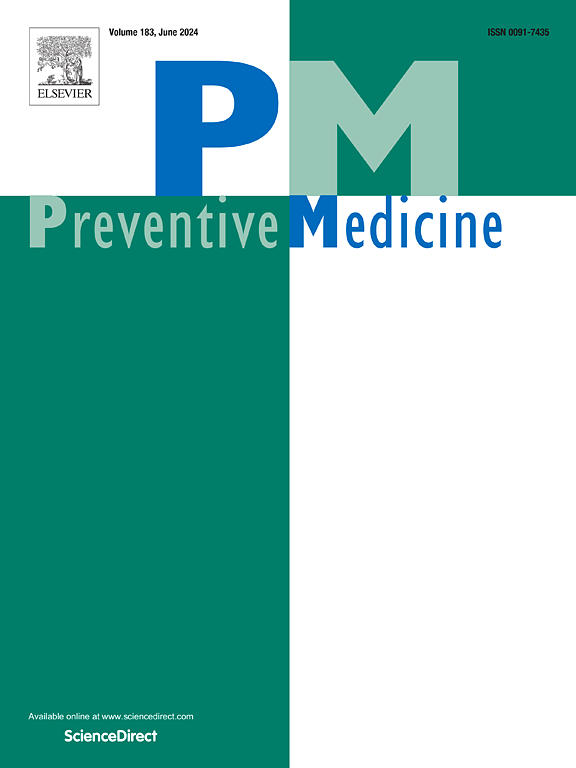国外出生的拉丁裔患者与美国出生的拉丁裔患者的动脉粥样硬化性心血管疾病的比较
IF 3.2
2区 医学
Q1 MEDICINE, GENERAL & INTERNAL
引用次数: 0
摘要
目的:动脉粥样硬化性心血管疾病(ASCVD)的负担可能因拉丁美洲人的出生国家而有所不同,因此,我们旨在研究ASCVD筛查服务利用率的差异,这一点尚未使用大型医疗数据集进行研究。方法:数据包括2014年至2020年美国(U.S.)社区卫生中心多州网络的电子健康记录(EHR)数据。研究人群(N = 49,177)为外国出生的拉丁裔(来自10个不同的拉丁国家)和美国出生的拉丁裔患者,年龄40-83 岁,在149 U.S.遍布14个州的社区卫生中心。为了比较ASCVD风险计算所需的医疗记录数据的流行程度,我们使用logistic回归进行了横断面分析,并根据人口统计学和卫生服务利用因素进行了调整。结果:调整后的优势比(aOR)比较外国出生和美国出生的拉丁裔为1.17(95 % CI = 1.01,1.35)。当按出生国家进行分层时,与美国出生的患者相比,来自特定国家的患者有更高的记录数据的几率(多米尼加共和国:aOR = 1.13,95 % CI = 1.03,1.24;萨尔瓦多:aOR = 1.26,95 % CI = 1.08,1.47;危地马拉:aOR = 1.17,95 % CI = 1.02,1.34;墨西哥:aOR = 1.19,95 % CI = 1.01,1.41)。结论:来自萨尔瓦多、危地马拉、多米尼加共和国和墨西哥的外国出生的拉丁美洲人更有可能在他们的电子病历中记录有评估心血管风险所需的文件信息。这些发现强调了拉丁裔患者数据分类的临床重要性,因为特定的国家出生地可能与心血管筛查的充分性有关。本文章由计算机程序翻译,如有差异,请以英文原文为准。
Atherosclerotic cardiovascular disease measures in foreign-born Latino patients by country of birth compared with U.S.-born Latinos
Objective
The burden of atherosclerotic cardiovascular disease (ASCVD) may differ based on the country of birth in Latinos, therefore, we aimed to examine differences in the utilization of ASCVD screening services, which have not been studied using large healthcare datasets.
Methods
Data included electronic health record (EHR) data from a multistate network of United States (U.S.) community health centers from 2014 to 2020. The study population (N = 49,177) was foreign-born Latinos (from ten different Latin countries) and U.S.-born Latino patients aged 40–83 years seeking care at 149 U.S. community health centers across 14 states. To compare the prevalence of documented medical record data necessary for ASCVD risk calculation, we performed a cross-sectional anlaysis, using logistic regression, adjusted for demographic and health services utilization factors.
Results
The adjusted odds ratio (aOR) comparing foreign-born to U.S.-born Latinos was 1.17 (95 % CI = 1.01, 1.35). When stratifying by country of birth, patients from specific countries had higher odds of documented data when compared to their U.S.-born counterparts (Dominican Republic: aOR = 1.13, 95 % CI = 1.03, 1.24; El Salvador: aOR = 1.26, 95 % CI = 1.08, 1.47; Guatemala: aOR = 1.17, 95 % CI = 1.02, 1.34; Mexico: aOR = 1.19, 95 % CI = 1.01, 1.41).
Conclusions
Foreign-born Latinos from El Salvador, Guatemala, the Dominican Republic, and Mexico are more likely to have documented information in their EHR necessary to assess cardiovascular risk. These findings underscore the clinical importance of data disaggregation in Latino patients as specific national birthplace may be associated with the adequacy of cardiovascular screening.
求助全文
通过发布文献求助,成功后即可免费获取论文全文。
去求助
来源期刊

Preventive medicine
医学-公共卫生、环境卫生与职业卫生
CiteScore
7.70
自引率
3.90%
发文量
0
审稿时长
42 days
期刊介绍:
Founded in 1972 by Ernst Wynder, Preventive Medicine is an international scholarly journal that provides prompt publication of original articles on the science and practice of disease prevention, health promotion, and public health policymaking. Preventive Medicine aims to reward innovation. It will favor insightful observational studies, thoughtful explorations of health data, unsuspected new angles for existing hypotheses, robust randomized controlled trials, and impartial systematic reviews. Preventive Medicine''s ultimate goal is to publish research that will have an impact on the work of practitioners of disease prevention and health promotion, as well as of related disciplines.
 求助内容:
求助内容: 应助结果提醒方式:
应助结果提醒方式:


